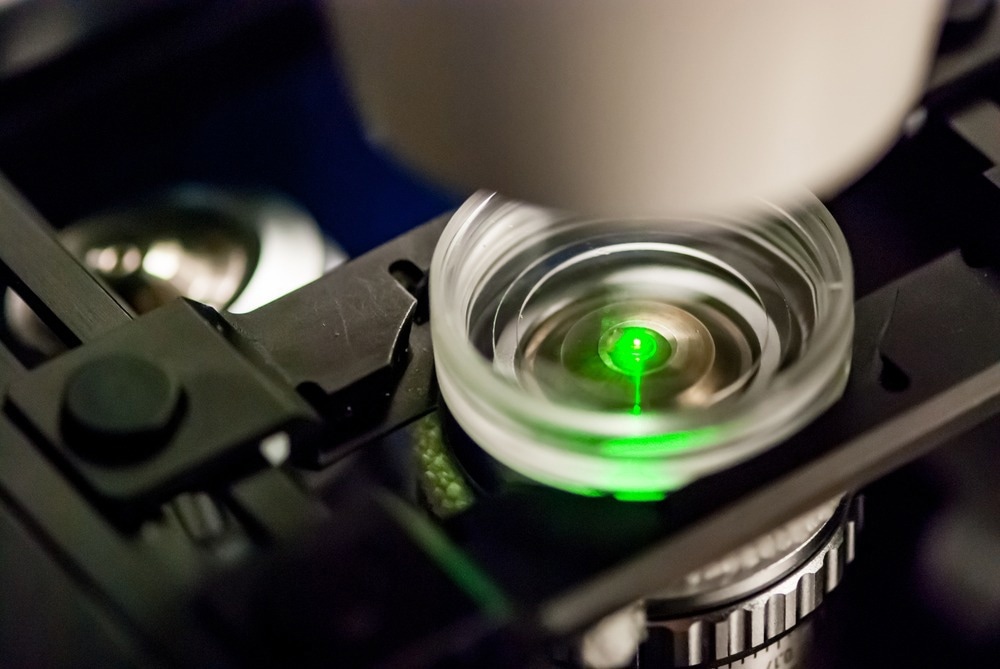A pre-proof study from Optics Communications introduces a microscopic image fusion technique to improve the signal-to-noise ratio, the dynamic range, and the root-mean-square contrast of dark-field confocal microscopy imaging. This method generates high-quality images with uniform brightness and improves the damage threshold of optical systems.

Study: Large Dynamic Range Dark-Field Imaging Based On Microscopic Images Fusion. Image Credit: Micha Weber/Shutterstock.com
Subsurface Defects and Their Impact on Optical Systems
Subsurface defects (SSD) such as scratches, pits, and micro-cracks are generated in the subsurface layer several hundred micrometers below the polished surface of the optical element.
SSD can reduce stability and the damage threshold of optical systems. Therefore, nondestructive testing of SSD is critical because valuable SSD data helps restore damaged optical components, enhances the quality, and extends the lifespan of an optical system.
Conventional SSD Detection Techniques
Various nondestructive optical measuring methods are utilized for SSD detection. Optical scattering imaging is among the most promising detecting approaches, which includes optical coherence tomography and confocal fluorescence microscopy.
Confocal fluorescent microscopy
Confocal fluorescence microscopy labels SSD during manufacturing using the colored liquid penetration technique. However, due to the complicated architecture of SSD, the fluorescent particles cannot penetrate all the damaged areas, resulting in a smaller measurement than the actual value.
Optical coherence tomography
Optical coherence tomography can detect deep defects in thick optical components and is suited for optical materials with high scattering. However, for optical materials with low scattering capabilities, SSD light scattering is weak, making signal capture and processing complex.
OCT's resolution is constrained by the light source's coherence length, making it hard to measure the width and depth of micron-sized fractures.
Dark-Field Confocal Microscopy (DFCM)
Dark-field confocal microscopy (DFCM) is the latest nondestructive testing method based on the scattering imaging principle that compensates for the shortcomings of traditional approaches and provides more accurate measurements.
Dark-field confocal microscopy utilizes oblique illumination to increase contrast in specimens not imaged well under normal illumination conditions. However, the images generated by DFCM have poor image brightness and dynamic range, which results in the loss of weak scattered signals and image details from micro-scale SSD.
Histogram correction algorithms and image fusion approaches are currently employed to enhance the dynamic range of DFCM imaging.
Using Microscopic Image Fusion Technique to Enhance Dark-Field Confocal Microscopy Imaging
Researchers proposed and demonstrated a wide dynamic range image fusion technique for DFCM imaging using results obtained from transparent materials with nano/micro subsurface structures.
The image fusion technique creates a composite image using data extracted from numerous source images of a single sample. A local edge-preserving filter deconstructs the image into a detailed and luminance image to generate several luminance images in the identical static background and a detailed fusion image with more edges.
The processed images are divided into a bright and a dark portion using the Otsu technique. The brightness of the bright and dark regions in the DFCM images is altered using an enhanced S curve.
The ideal luminance conversion parameters are chosen by estimating the entropy of the images whose brightness will be altered.
The best low and high luminance images are produced by transforming the brightness of the decomposed luminance image using the optimal luminance transformation parameters. The deconstructed image is then transformed once again using the S curve.
An image with medium brightness is produced by determining the overall luminance transform image's optimal image entropy. After applying these procedures to luminance transformation, images with distinct brightness and varying illumination are obtained.
After performing a weighted fusion operation on images with varying illumination, a high signal-to-noise ratio, high contrast, and a wide dynamic range image is created, which allows the detection of weak scattered signals from micro-scale subsurface defects.
Significant Findings of the Study
The proposed image fusion-based dark-field confocal microscopy imaging approach produces images with greater detail and consistent image brightness than traditional methods. This technology can simultaneously demonstrate strong and weak scattered signals by preventing large-scale subsurface defects from saturating strong scattered signals.
The weak SSD information concealed in the background is improved without enhancing the background noise by effectively extending the photos' dynamic range.
The optimal root-mean-square contrast, dynamic range, image entropy and signal-to-noise ratio of the processed images are enhanced by 2.06, 3.30, 3.45, and 13.55 times respectively.
The proposed technology enhances subsurface defects detection in dark-field confocal microscopy and prevents micro-scale subsurface defects from going undetected. In addition, it is useful for repairing optical elements and significantly improves the damage threshold of optical systems.
Reference
Liu, J., Liu, C., Zou, C., Zhao, Y., & Liu, J. (2022). Large Dynamic Range Dark-Field Imaging Based On Microscopic Images Fusion. Optics Communications. https://www.sciencedirect.com/science/article/abs/pii/S0030401822006137
Disclaimer: The views expressed here are those of the author expressed in their private capacity and do not necessarily represent the views of AZoM.com Limited T/A AZoNetwork the owner and operator of this website. This disclaimer forms part of the Terms and conditions of use of this website.